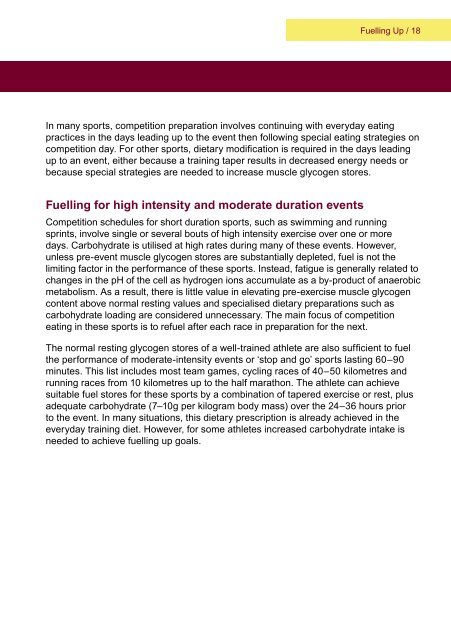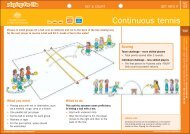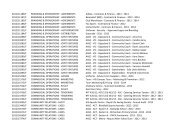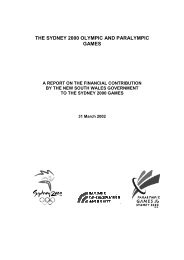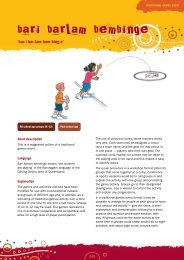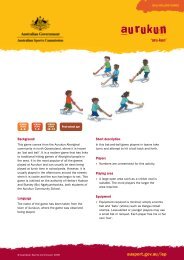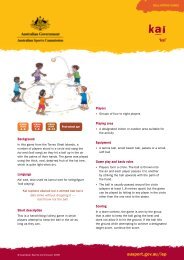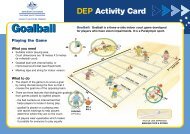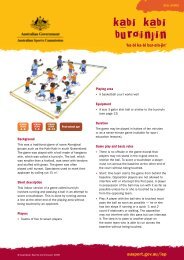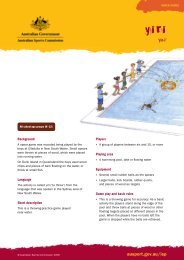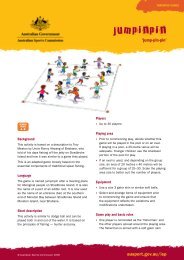Current Concepts in Sports Nutrition - Australian Sports Commission
Current Concepts in Sports Nutrition - Australian Sports Commission
Current Concepts in Sports Nutrition - Australian Sports Commission
You also want an ePaper? Increase the reach of your titles
YUMPU automatically turns print PDFs into web optimized ePapers that Google loves.
Fuell<strong>in</strong>g Up / 18<br />
In many sports, competition preparation <strong>in</strong>volves cont<strong>in</strong>u<strong>in</strong>g with everyday eat<strong>in</strong>g<br />
practices <strong>in</strong> the days lead<strong>in</strong>g up to the event then follow<strong>in</strong>g special eat<strong>in</strong>g strategies on<br />
competition day. For other sports, dietary modification is required <strong>in</strong> the days lead<strong>in</strong>g<br />
up to an event, either because a tra<strong>in</strong><strong>in</strong>g taper results <strong>in</strong> decreased energy needs or<br />
because special strategies are needed to <strong>in</strong>crease muscle glycogen stores.<br />
Fuell<strong>in</strong>g for high <strong>in</strong>tensity and moderate duration events<br />
Competition schedules for short duration sports, such as swimm<strong>in</strong>g and runn<strong>in</strong>g<br />
spr<strong>in</strong>ts, <strong>in</strong>volve s<strong>in</strong>gle or several bouts of high <strong>in</strong>tensity exercise over one or more<br />
days. Carbohydrate is utilised at high rates dur<strong>in</strong>g many of these events. However,<br />
unless pre-event muscle glycogen stores are substantially depleted, fuel is not the<br />
limit<strong>in</strong>g factor <strong>in</strong> the performance of these sports. Instead, fatigue is generally related to<br />
changes <strong>in</strong> the pH of the cell as hydrogen ions accumulate as a by-product of anaerobic<br />
metabolism. As a result, there is little value <strong>in</strong> elevat<strong>in</strong>g pre-exercise muscle glycogen<br />
content above normal rest<strong>in</strong>g values and specialised dietary preparations such as<br />
carbohydrate load<strong>in</strong>g are considered unnecessary. The ma<strong>in</strong> focus of competition<br />
eat<strong>in</strong>g <strong>in</strong> these sports is to refuel after each race <strong>in</strong> preparation for the next.<br />
The normal rest<strong>in</strong>g glycogen stores of a well-tra<strong>in</strong>ed athlete are also sufficient to fuel<br />
the performance of moderate-<strong>in</strong>tensity events or ‘stop and go’ sports last<strong>in</strong>g 60–90<br />
m<strong>in</strong>utes. This list <strong>in</strong>cludes most team games, cycl<strong>in</strong>g races of 40–50 kilometres and<br />
runn<strong>in</strong>g races from 10 kilometres up to the half marathon. The athlete can achieve<br />
suitable fuel stores for these sports by a comb<strong>in</strong>ation of tapered exercise or rest, plus<br />
adequate carbohydrate (7–10g per kilogram body mass) over the 24–36 hours prior<br />
to the event. In many situations, this dietary prescription is already achieved <strong>in</strong> the<br />
everyday tra<strong>in</strong><strong>in</strong>g diet. However, for some athletes <strong>in</strong>creased carbohydrate <strong>in</strong>take is<br />
needed to achieve fuell<strong>in</strong>g up goals.


